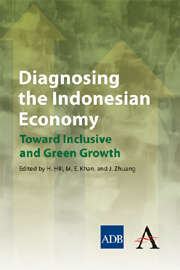Book contents
- Frontmatter
- Foreword
- Preface
- Author Profiles
- Abbreviations and Acronyms
- Contents
- 1 Introduction
- 2 Development Policies and Performance
- 3 Critical Constraints to Growth
- 4 Critical Constraints to Reducing Poverty and Inequality
- 5 Macroeconomic Management
- 6 Industrialization: Patterns, Issues, and Constraints
- 7 Infrastructure Development: Challenges and the Way Forward
- 8 Human Capital and Economic Development
- 9 Economic Growth, Employment Creation, and Poverty Alleviation
- 10 Poverty Reduction: The Track Record and Way Forward
- 11 Decentralization
- 12 Making Indonesia's Growth Green and Resilient
- Index
5 - Macroeconomic Management
Published online by Cambridge University Press: 05 May 2012
- Frontmatter
- Foreword
- Preface
- Author Profiles
- Abbreviations and Acronyms
- Contents
- 1 Introduction
- 2 Development Policies and Performance
- 3 Critical Constraints to Growth
- 4 Critical Constraints to Reducing Poverty and Inequality
- 5 Macroeconomic Management
- 6 Industrialization: Patterns, Issues, and Constraints
- 7 Infrastructure Development: Challenges and the Way Forward
- 8 Human Capital and Economic Development
- 9 Economic Growth, Employment Creation, and Poverty Alleviation
- 10 Poverty Reduction: The Track Record and Way Forward
- 11 Decentralization
- 12 Making Indonesia's Growth Green and Resilient
- Index
Summary
Introduction
The government has navigated the economy through two major economic crises since 1997. In the 1997 Asian financial crisis (AFC), Indonesia was the most severely affected economy in the Asian region, and its economic growth dipped by 13.4% in 1998 (Figure 5.1a). In contrast, Indonesia was among the countries least affected by the recent global financial crisis (GFC), when its economic growth declined only to 4.5% in 2009. The country used the lessons it learned from the AFC to introduce significant economic reforms afterward. This improved Indonesia's macroeconomic management, contributing to the country's resilience during the recent GFC. Indonesia's better performance was attributable to the government's appropriate and swift policy responses, limited exposure to the source of the crisis, and less reliance on exports. Further reforms have also been implemented to reduce vulnerabilities identified during the recent GFC.
However, significant challenges remain. Post-crisis economic management restored economic growth to an average of 5.1% during 2000–2009, but growth remains far below the pre-crisis level of 7%–8%. While poverty and unemployment have declined, they remain relatively high. On average, inflation has declined, but it is still higher and more volatile than in other countries in the region. At the same time, increasing short-term capital inflows complicate the conduct of monetary policies. In this context, the government has set higher targets.
- Type
- Chapter
- Information
- Diagnosing the Indonesian EconomyToward Inclusive and Green Growth, pp. 149 - 182Publisher: Anthem PressPrint publication year: 2012



